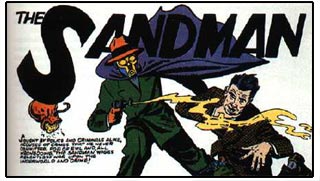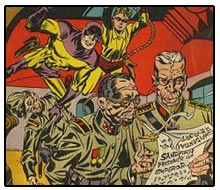| 1x10c:
Enter Sandman
A gas
mask and a business suit. This is the costume that the Golden
Age Sandman wore to fight crime. A gas mask and a business
suit. Sounds absurd, right? So why is the character so memorable
and interesting?
The Sandman
was a second-rate character for most of his existence. First
appearing in New York World’s Fair Comics in 1939
in a story by Gardner Fox and Bert Christman, Wesley Dodds
was a millionaire inventor who invented a gas gun that would
force those exposed to the gas to tell the truth. Donning
his gas mask and business suit, essentially street clothes,
the Sandman faced and defeated mainly ordinary criminals in
this phase of his career, albeit unusually sadistic and cruel
criminals.
One of
the first costumed characters to emerge from DC Comics after
the success of Superman, the Sandman seems as much a pulp
magazine character as a super-hero as we think of them. Seen
in this light, the idea of wearing a gas mask and a business
suit to fight crime makes sense. He’s a transitional
character between pulp heroes like Doc Savage, The Shadow
and The Spider, and costumed crime-fighters such as Batman
and Captain America. After the World’s Fair one-shot,
Sandman began appearing in Adventure Comics beginning
in issue 40 from that same year.
The Sandman
briefly was popular when comics were new, appearing as a charter
member of the Justice Society in 1940 and appearing in the
following 29 issues of Adventure Comics in his unusual
costume. However, as new and more colorful characters continued
to appear, The Sandman seemed more and more like a relic of
times past. It was decided that the character should be revamped,
and in Adventure Comics #69, 1941, at the hands of
artist Chad Grothkopf, he donned a rather garish yellow and
purple costume, was given a teen sidekick, called Sandy, and
even gave up his gas gun, replacing it with a "wirepoon."
In late
1941, the team supreme of Joe Simon and Jack Kirby were assigned
to the strip, and the transition from its pulp roots was complete.
Instead
of dark and mysterious crime fiction, Sandman became
a classic Simon and Kirby all-action strip. This transition
helped the comic to survive the World War II era by embracing
many of the fashions of the day.
By 1946,
however, as the comics industry evolved away from super-heroes,
Sandman disappeared from sight. He left the Justice Society
in 1945, and appeared his last in Adventure Comics,
one year later, with issue #102.
The Sandman
appeared again over twenty years later, with the rest of his
pals from the Justice Society, in Justice League of America
#46, 1966. That story found The Sandman back in his original
outfit of a gas mask and business suit. He was an intriguing
character because of his unique look, but always seemed to
keep pretty much to the background. In JLA #113, he
did step to the forefront as the fate of his partner Sandy
was resolved, but despite his unique look, the Golden Age
Sandman was always a secondary player in the JLA/JSA team-ups.
When the JSA stepped into their own series with All-Star
Comics #57 in 1976, The Sandman wasn’t one of the
featured players. The writing was on the wall and Wesley Dodds
looked to be headed to the limbo of forgotten comics characters.
Forgotten,
that is, until a new, or rather very old, character called
The Sandman began appearing in his own series beginning in
1988. You may have heard of this series – written by
Neil Gaiman, The Sandman was one of the most critically-acclaimed
and popular comics of the 1990s. One of the key points of
the series was that Morpheus, Dream of legend, had been imprisoned
for 70 years in a crystal by an Aleister Crowley analogue
who actually was trying to trap Dream’s sister Death.
In Dream’s absence, the horrors of the 20th century were
unleashed. World War I, the Holocaust, Vietnam – these
horrific events occurred because dreams were out of control
since they had lost their master.
One other
side effect was that some dreams leaked out to minds that
were sensitive to the vibrations of the Dreaming. One of those
men was millionaire Wesley Dodds, who in the 1930s dreamed
of horrific crimes and was compelled to fight them. Donning
a gas mask, an analogue to Morpheus’s battle mask, and
carrying a gas that forces those who breathe it to tell the
truth, Dodds was compelled to fight evil acts that occur in
and around New York City.
Emerging
in 1939 to fight the serial murderer The Tarantula, Dodds
was a crimefighter driven by his own nightmares to end the
nightmares of others. He simply had no choice but to fight
crime. It was either that, or go crazy...
For the
full article, go to Once
Upon A Dime!
|







